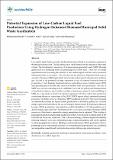Potential Expansion of Low-Carbon Liquid Fuel Production Using Hydrogen-Enhanced Biomass/Municipal Solid Waste Gasification
Author(s)
Ostadi, Mohammad; Cohn, Daniel R.; Zang, Guiyan; Bromberg, Leslie
Downloadsustainability-17-05718.pdf (4.758Mb)
Publisher with Creative Commons License
Publisher with Creative Commons License
Creative Commons Attribution
Terms of use
Metadata
Show full item recordAbstract
Low-carbon liquid fuels are needed for decarbonization of hard-to-decarbonize segments of the transportation sector. This decarbonization can be limited by the amount of renewable carbon. Thermochemical conversion of biomass/municipal solid waste (MSW) through gasification is a promising route for producing low-carbon fuels. There are two major opportunities for increasing the amount of low-carbon liquid fuel that can be produced from gasification in any region. One is to increase the amount of liquid fuel from a given amount of biomass/MSW, particularly by hydrogen-enhancement of gasification synthesis gas. Second is the potential for large expansion of use of biomass feedstocks from its present level. Such biomass feedstocks include agricultural waste, forestry waste, MSW, and specially grown biomass that does not interfere with food production. The use of MSW may provide advantages of an established network for pickup and transportation of feedstock to disposal sites and the avoidance of methane produced from landfilling of MSW. As a case study, we looked at potential expansion of US low-carbon fuel production, considering the recent projections of the 2024 USDOE report, which estimated potential production of a billion tons/yr of biomass/MSW feedstocks in the US. This report included an estimated potential for liquid biofuel production of 60 billion gallons/yr of diesel energy equivalent fuel without the use of hydrogen enhancement. By hydrogen-enhanced biomass/MSW gasification, this projection could be doubled to 120 billion gallons/yr of diesel energy equivalent fuel. Furthermore, the co-location potential of biomass/MSW resources with potential renewable energy generation sites is explored. This overlap of hydrogen production and biomass production in the US are located in regions such as the US Midwest, Texas, and California. This co-location strategy enhances logistical feasibility, reducing transport costs and optimizing energy system integration; and can be applied to other geographical locations. Hydrogen-enhanced biomass/MSW gasification offers a promising route to substantially increase low-carbon liquid fuel production (e.g., methanol) and support increased liquid fuel production and greenhouse gas reduction goals.
Date issued
2025-06-21Department
MIT Energy Initiative; Massachusetts Institute of Technology. Plasma Science and Fusion CenterJournal
Sustainability
Publisher
Multidisciplinary Digital Publishing Institute
Citation
Ostadi, M.; Cohn, D.R.; Zang, G.; Bromberg, L. Potential Expansion of Low-Carbon Liquid Fuel Production Using Hydrogen-Enhanced Biomass/Municipal Solid Waste Gasification. Sustainability 2025, 17, 5718.
Version: Final published version